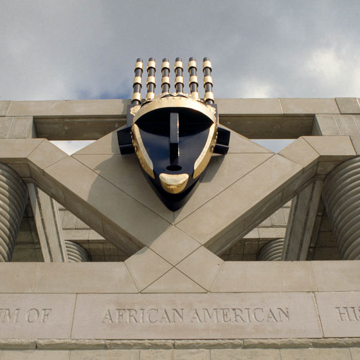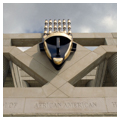This huge museum of African American history expresses its purpose in form, motifs, and detail. The dome above a rotunda is based on African buildings, and the sculptural columns mimic a traditional African rope motif. The brass, bronze, mahogany, and marble materials are native to Africa. African masks, designed by Richard Bennett, mark the entrance and state the function.
Dr. Charles Wright (1918–2002), a Detroit physician and historian, founded the Museum of African American History in 1965. First housed in two dwellings, the museum was moved in 1987 to a larger building. One year after the current museum opened, it was rededicated and renamed for Wright. At its dedication the museum was the largest of its kind ever built. Its supporters anticipated it would serve as a national tourist destination, but attendance and revenue declined in 2004. Since then new core exhibits have been installed.





